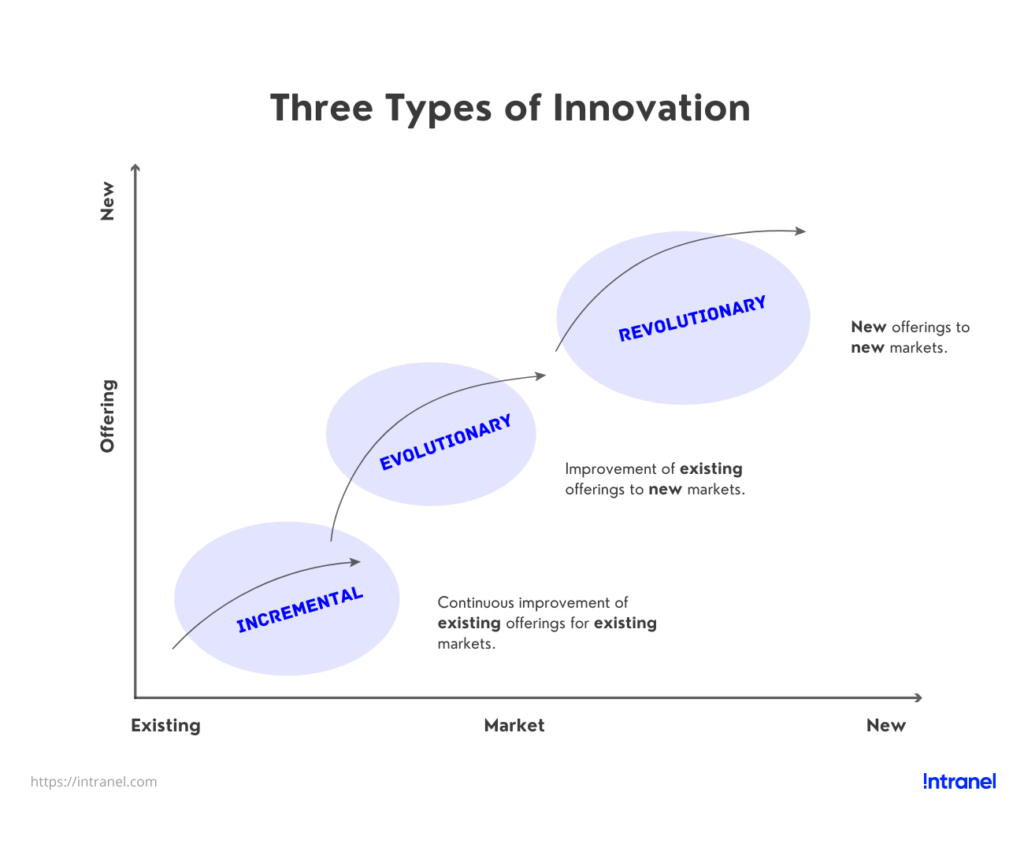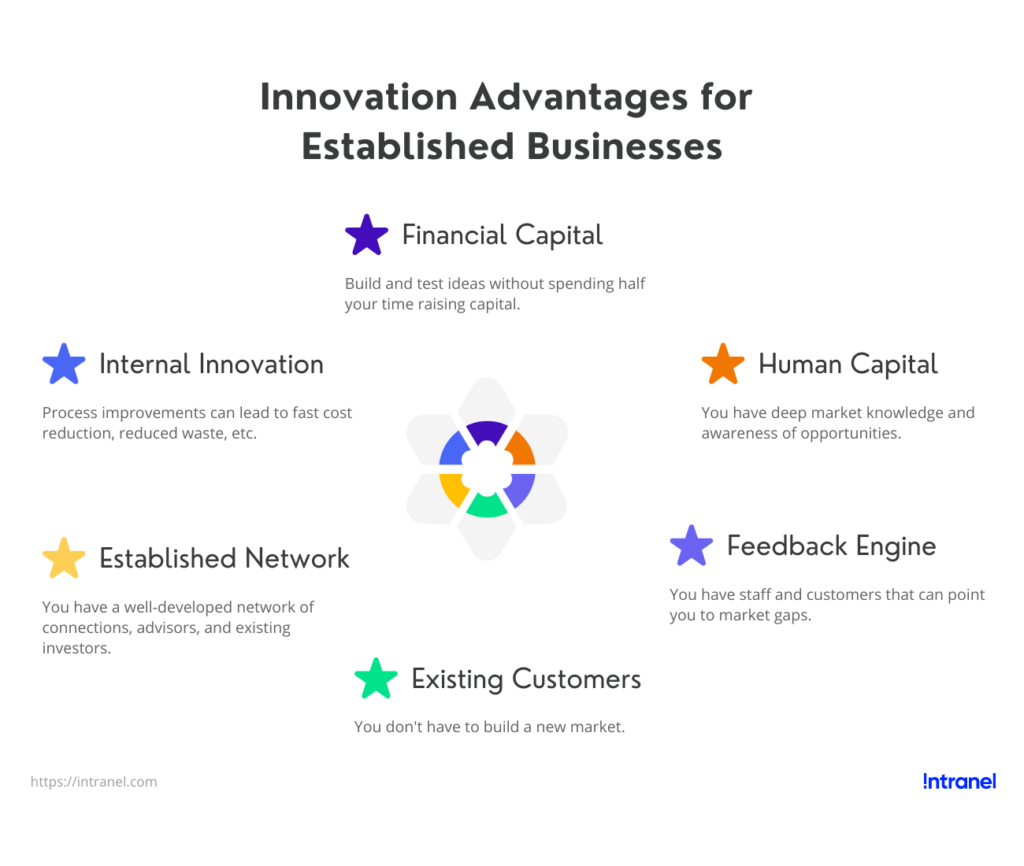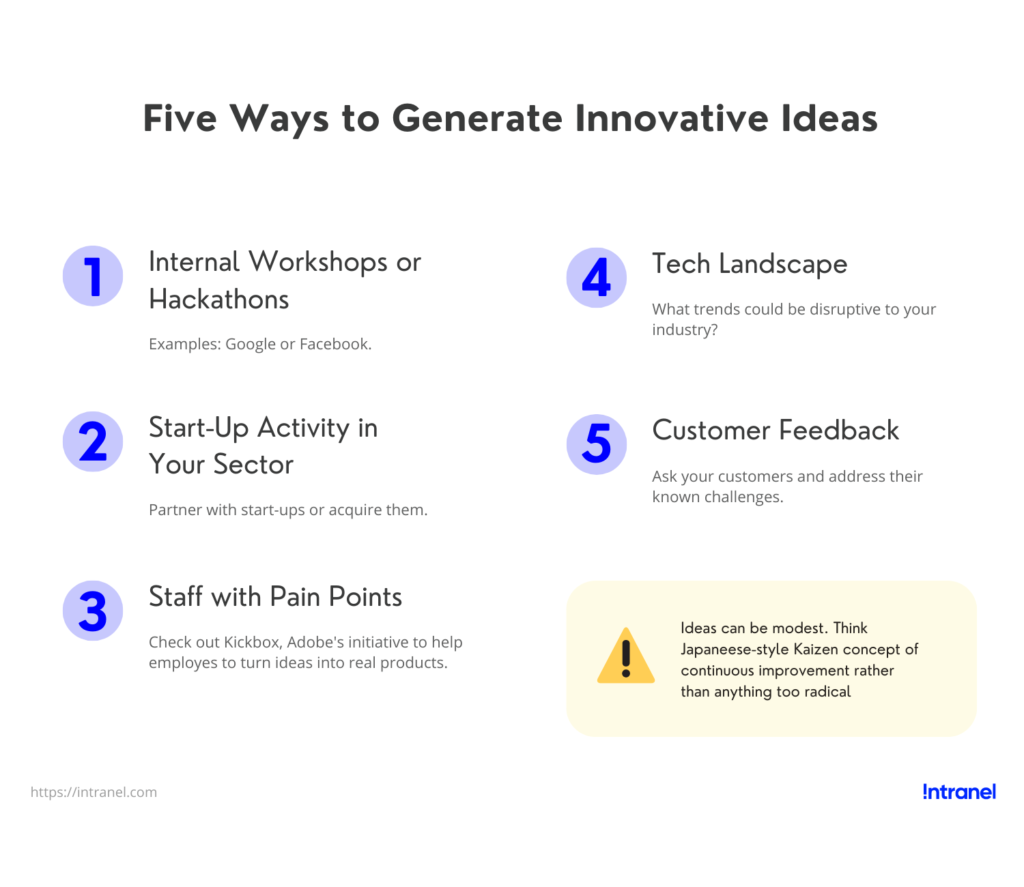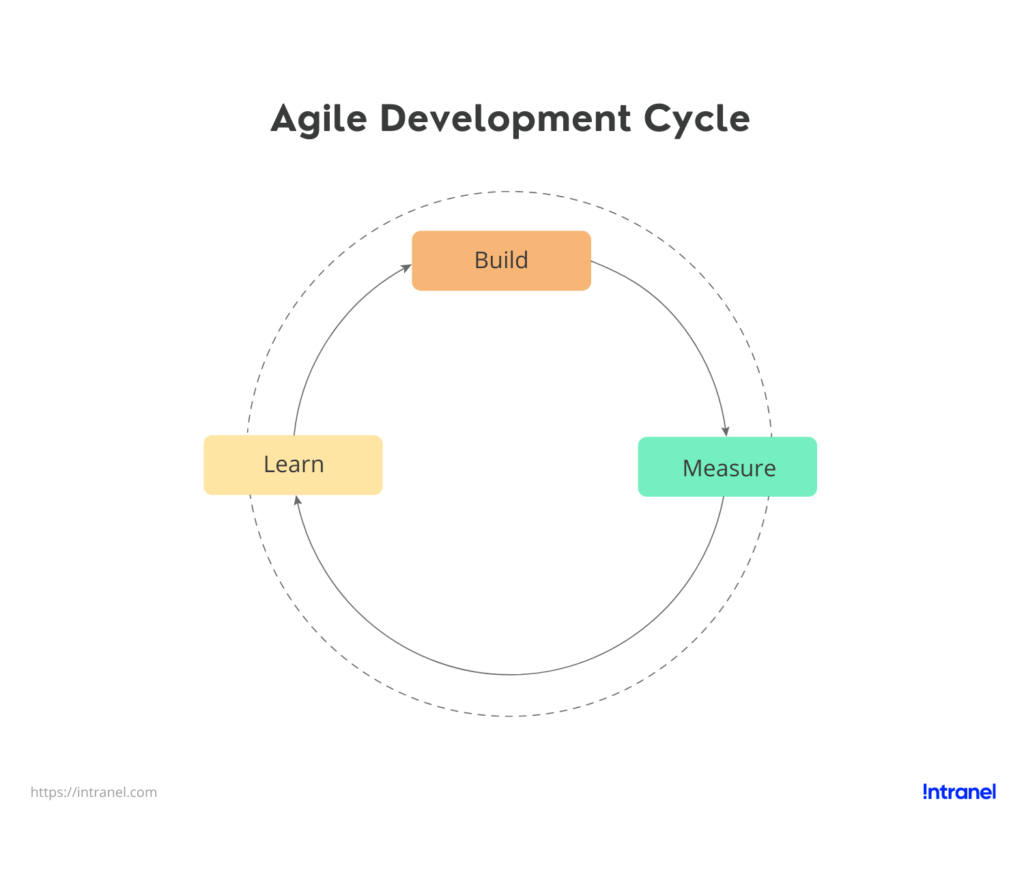When it comes to creating a competitive advantage through innovation, established businesses have major advantages. They are already a domain expert with deep knowledge of the market they serve. By adopting a start-up mentality, they can combine these advantages with the cost and time-to-market benefits of lean methodologies.
In this guide, I am going to explore what established organisations can borrow from start-ups to innovate better, and how they can build an efficient process around innovation. We’ll go through the following topics:
- What is innovation?
- The different types of innovation
- Four reasons why innovation is important for New Zealand businesses
- How to overcome main challenges with innovation
- Seven steps to build a better innovation process
- When your MVP is built—what’s next?
- Sources of funding and where to get support
Let’s dive in.
What is innovation?
So what is “innovation” and where does it sit in the big picture?

- Creating value from ideas
Innovation is a fairly subjective term—it takes many forms and is not always disruptive. To me, innovation broadly means “creating value from new ideas”.
- Novelty
An innovative idea tends to be novel, or at least it implies a new approach and differentiates you from competitors. With anything novel, there’s an element of risk and uncertainty so it’s a process of discovery. The element of novelty is important—building a basic mobile app 20 years after everyone else may feel innovative but it probably isn’t.
- Closely linked to Research & Development (R&D)
Innovation is closely linked to R&D which is also a slippery term. I tend to use R&D and innovation fairly interchangeably, although in business we tend to think of commercial outcomes from innovation.
- Ultimately enabled by scientific research
It’s worth remembering that pure research is vital as the ultimate driver of other innovations. Bardeen and Brattain at Bell Laboratories needed to be curious about the fundamental properties of semiconductors to enable the internet to happen 30 years later.
The different types of innovation
Innovation comes in different flavours and it’s OK to be a little bit vanilla in this respect. I am going to split it into three different types:
- Incremental innovation
- Evolutionary innovation
- Revolutionary innovation
Let’s take a brief look at each (along with examples).

Incremental innovation
Continuous improvement of existing offerings for existing markets.
If we’re using a car analogy we could say that Ford’s Eco Boost is a fairly incremental innovation as it’s a tweak to fuel efficiency on an existing vehicle.
Evolutionary innovation
Improvement of existing offerings to new markets.
We could call the Toyota Prius evolutionary with its hybrid power chain, evolution from a standard vehicle to a vehicle that splits gas and electric power.
Revolutionary innovation
New offerings to new markets.
For example, the Tesla Model S with its purely electric drive is an example of revolutionary innovation. I have second thoughts on the Tesla example as it is not exactly that radical. It still has 4 wheels and an engine, albeit electric.
A better and more local example might be a company like Halter which does what it says on the tin and puts halters on cattle to provide gentle directional prompts. The revolutionary innovation here is you can now move your herd around with a mobile app and can eliminate mustering and fences, a huge chunk of the current work in farming.
Four reasons why innovation is important for NZ businesses
- Driver of growth
At a national level, conversations about improving our collective prosperity are often linked to productivity growth. Innovation is a key driver of growth, especially in the tech sector.
- Innovation can be a tool for good
I use the term “growth” in a broad sense and include challenges like mitigating climate change and inequality as well as raw economics.
- Low R&D spend
It’s a big subject, but there’s an acceptance that NZ businesses can do better—NZ’s R&D spend sits well down the OECD average.

- Lack of natural resources
If we can innovate more efficiently and improve its returns to business we can build a better economy without scaling extractive industries. Unlike Australia, NZ can’t just dig another hole so, in a nutshell, businesses need to do things smarter.
What are the advantages for established businesses?
Let’s look at the advantages that established businesses have over start-ups when it comes to innovating:
- Financial capital—You have the resources to build and test ideas without spending 50% of your time raising capital.
- Human capital—You have a deep understanding of your market and are aware of opportunities.
- Feedback engine—You have employees and customers that can point you to market gaps.
- Existing customers—You don’t have to build a new market.
- Established network—You have a well-developed network of connections, including advisors and investors.
- Internal innovation—Any innovative ideas that your business filter through are a response to a real, validated need from your operations. Internal process improvements can lead to benefits like fast cost reduction or reduced waste.


New start-ups fail because developing capability, product-market fit, and building a customer base is difficult and risky. As an established business, you are are off to a big head start in all these areas.
There are plenty of examples of established innovation engines across businesses. Think Amazon’s Web Services, now one of their most lucrative products which came from the infrastructure they’d already built around retail sales.
3M’s is another example. A massive conglomerate but their whole brand is built around science and innovation. The story of 3M post-it notes is a good example of bias towards success stories in innovation. The short version goes that they were attempting to create a strong adhesive and accidentally discovered a weak one that peeled off everything. They were about to throw the new glue away before realising the potential for a removable adhesive, and the amazing post-it note was born.
Remember that innovation isn’t space for 20-something grads running start-ups and Elon Musk types. As an established business, you are already a domain expert, have deep knowledge of your market space, and (most importantly) have customers. Jackpot!
It also turns out that most successful entrepreneurs tend to be over 40 and have worked in the industry for some time. Domain experience counts for a lot.
How to overcome main challenges with innovation
Despite their advantages, established organisations often have cultural, resourcing, and leadership constraints that can cramp innovation:
- Businesses don’t like uncertainty—Innovation is uncertain by definition.
- Risk aversion—Perceived risks vs returns doesn’t create a clear business case.
- Burnt in the past—When companies did try innovating but it didn’t work out.
- Short-term thinking—The CEO won’t make a bonus if capital is directed to innovation.
Let’s go back to our 3M example. In reality, the innovation behind post-it notes bounced around internally for 10 years and had multiple knock-backs by senior management and failed launches before they finally achieved product-market fit by sending truck tonnes of free samples to offices. Only at that point did many businesses fall in love with the post-it notes and re-order them.
F.E.A.R. or Frustrated Entrepreneurs Avoid Risk
OK, I just made this acronym up and it’s not a thing.
But in essence, risk aversion is a big barrier to innovation.
Innovation is risky by definition and may take several years to generate ROI. This can create pressure from stakeholders and senior leadership trying to meet short-term financial targets.
On top of this, you need to take care of practical stuff around:
- Who leads innovation projects
- How you fill knowledge and capacity gaps
- How you build acceptance of a “fail fast culture” where new ideas can be tested efficiently without fear of failure
One example of this is a project we did with the Royal Bank of Scotland in London in 2011-2012. The goal was to create an innovative online platform for SMEs.

Innovation can be difficult and time-consuming and sometimes only makes it across the line by the narrowest of margins.
We helped them do just that and produced several concepts, with the favourite being an idea called Reputate. This was a novel way to help businesses build a reputation score based on interactions with customers, a little similar to how TrustPilot operates now.
With over 2 million SME customers the bank was in a strong position to achieve critical mass pretty quickly. We spent several months helping refine the concept for an MVP build. Everything was going swimmingly until senior people 2 levels over our head got a hold of the project and forced a pivot back to a much less innovative content platform.
The basic issue was that the brand had already been trashed in the media after massive government bailouts in the wake of the Global Financial Crisis and their risk appetite was very low. A good example of how it’s harder to innovate if you’ve lost your social license.
The F.E.A.R. response is understandable but in NZ especially we need to shift the balance more towards G.R.E.E.D.

G.R.E.E.D. or Greater Returns on Equity through Effective Development
OK, I just made that up too—it’s not a thing either. The benefits of innovation are fairly self-evident. The trick to more successful innovation is to instill techniques and processes that give leaders the confidence to make more investments.
Seven steps to build a better innovation process
Start-up methodologies have evolved to reduce risks by using proven techniques to evaluate new ideas, or how to “fail fast” in a start-up lingo.
Start-ups are small and tight on resources, so focus is essential. Having more choices around a complex existing business model can make that focus harder to achieve.
So if we’re thinking like a start-up, what is a good innovation process? It involves seven main steps:
- Figure out what innovation means to you
- Build your innovation pipeline
- Evaluate your opportunities
- Create a sandbox for innovation
- Build your dream delivery team
- Create a Minimum Viable Product (MVP) using agile methodologies
- Test your product-market fit
Let’s unpack each step.

1. Figure out what innovation means to you
Organisations need to focus at a leadership level to establish what innovation should mean for them.
Innovation strategy is going to be influenced by the sector you’re in, your internal capabilities, and the competitive landscape. An early-stage med-tech business is likely to be more innovation-focused than a lines company.
You might explore how can you take advantage of emerging tech like AI, what digital convergence and big data mean for you, and most importantly, who’s going to eat your lunch if you don’t innovate. How nimble your organisation is and where innovation sits currently will also shape your thinking.
A good way to do that is to put your entrepreneurial hat on and look at opportunities within your sector. Pretend you’ve resigned, stolen your dream team of three people from your organisation as well as the client database and you’re going to create your start-up after mortgaging your house.
I can never understand why this thought exercise isn’t popular with clients because it is legit.
2. Build your innovation pipeline
Once you have a rough idea of what you want to achieve through innovation, you can start to build an innovation pipeline. It starts with an ideas engine.
A suggestion box won’t cut it, although you probably don’t have to fly everyone off on corporate retreats to Bali. How you incentivise your team to think like entrepreneurs and get creative with ideas is unique to every organisation. Understanding challenges “at the coal face” from staff and customers can be a gold mine of opportunities.

I’ve seen plenty of examples of customer-driven innovation in the contracting space. When multiple clients are paying you to solve similar problems, this is a gift-wrapped market-validated idea with the potential to turn into a new product.
A great example is a Christchurch-based software company Webtools which built and spun off its Webtools Energy SaaS platform after observing that several market players had similar challenges.
Other ways to actively generate new ideas might include internal hackathons, a tool that enables Facebook to explore new ideas.
If you are looking for ways to help your employees turn your ideas into real products, it is worth checking out Kickbox, an open-source tool created by Adobe.
Remember ideas can be modest. Think Japanese-style Kaizen concepts of continuous improvement rather than anything too radical.
3. Evaluate your opportunities
When evaluating and refining ideas you need to be in a creative mindset. This is why it’s important to give your key staff time to focus outside the pressures of routine business. Easier said than done, I know.
One way to evaluate opportunities is through an elevator pitch competition. The rules are easy. You’ve got one minute to explain what the project is and how it creates value. The best ideas will win the competition.
It is also worth exploring more sophisticated tools like the lean canvas to weigh and evaluate your ideas.

4. Create a sandbox for innovation
Before your project kicks off, keep in mind that innovation requires a different mindset from routine operations. You need to get your innovation team away from risk and process-driven areas of the business, as well as from “people resistant to change”. This includes a fire-walled sandbox to develop and build ideas in a risk-managed way.
Speaking of risk, when executing new tech you may be more exposed to brand risk than a start-up—one of the reasons businesses look to innovate by acquisition rather than building in-house.
A good example of different risk appetites at play was when Intranel was working with a crypto-currency business in its start-up phase several years ago.
One of the presenters at the NZ Blockchain conference got excited about the potential for a tokenised NZD. Internally our conversation was “how quick could we do this?”, with the answer being “overnight”.
We proceeded to do just that. As a start-up, we were more focused on the technical process and being first to market rather than boring stuff like risk and compliance—we could worry about them late.
The product was fairly successful but the issue was that we depended on banking partners to provide fiat off-ramps and on-ramps for the tokens. Banks were simultaneously excited about Distributed Ledger Technology (DLT) but also terrified about the brand risk of negative headlines. Risk aversion ultimately won and we had accounts closed on us.
The same thing still happens with crypto exchanges playing a cat and mouse game with banks in Australia. It is a balancing act but in this case, banks are missing out on innovation in the Fintech industry partly because they’re not great at sandboxing innovation.
5. Build your dream delivery team
To build your MVP you will need to scale your innovation team into a delivery team. Here’s how you can do that:
- Identify knowledge/resource gaps
If you’re investing in innovation, chances are that you’re probably buried delivering to existing customers. Building a team requires identifying knowledge or resourcing gaps.
- Choose leaders comfortable with the dynamic environment
Getting the right people into technical leadership is crucial here. Start-ups conventionally have hackers on the tech side and hustlers on the market side working together to iterate a product and reprioritise features as your knowledge evolves. Hopefully, you’ve got equivalent personalities within your organisation.
- Keep your leadership/product owner roles internally
It’s OK to bring external resources in to help out, but key Leadership and Product owner roles should reside within your organisation and have time to focus.
- Get your delivery team away from risks
Give your key staff a chance to work outside the routine business—it can be very rewarding and help you retain talent.
6. Build MVP using agile methodologies
Once your sandbox team has fleshed out some ideas, you can start to refine them into an MVP. Start-ups draw heavily on lean thinking to test an innovative idea through building an MVP as quickly and cheaply as possible.
For me, this means a razor-sharp focus on the simplest, fastest way to evaluate an idea. When we do this at Intranel, the process usually starts by generating about 4 million cool features around an idea which then have to be painfully filtered down to 10 essential MVP ones, with the “nice-to-haves” buried safely in a product backlog.
An MVP should be market testable but shouldn’t be scalable from day one or form a critical part of your existing business processes. The idea is to fail fast or succeed fast, with minimal investment.

Remember that as you re-prioritise or add features, you learn more and your MVP may change. Iteration is a normal and expected part of the process.
Start-ups typically follow the agile development approach to build an MVP—it evolved to deal with uncertainties inherent in any innovative project.

Agile development aligns spending with an iterative learning process around value creation rather than starting with arbitrarily fixed budgets and delivery times. Letting go of a detailed budget and project plans at the start of a project is difficult but just accept you’re going to end up doing this anyway. Uncertainty comes hand in hand with innovation.
The good news is that once a project gets going you’ll start to get more useful data on velocity (how quickly features are getting delivered).
7. Test your product-market fit
I’m a tech lead so I tend to think about the marketing last.
But you can’t validate an idea without testing the concept with actual customers. Even if the innovation is purely internal there will still be users and they’ll need to find it valuable to want to use it.
An innovative product can still fail without innovative marketing, and the right product-market fit and go-to-market plan. Unfortunately, start-up practice tells us we can’t just ask customers if they like our new idea. This is the equivalent of asking your mum if your idea is awesome. She’ll almost certainly tell you that it is, and also that you’re very handsome.
Validation is all about behaviour, and for start-ups, this means “Will someone hand over actual money?”.
Start-ups will often test-market a product before they’ve even invested in building it. For example, Kickstarter is a great validation tool. It removes the risks of investing in scaling a product or service before securing customers.

It is crucial to market test your idea early on while communicating the risks clearly and managing user expectations. This allows you to iterate the idea several times before calling success or failure.
In some cases, an established business can use similar approaches, or if you’re in the B2B space you may be able to get written assurances that a customer will pay for a new product. If the market validation isn’t working you may need to iterate your MVP or the messaging around it.
There are books like “The Mom Test” to help with this. Established businesses can often take a shortcut here if the innovation addresses already expressed customer needs, or it improves efficiencies within the organisation.
In either case, you may be fairly confident that the idea adds value—your uncertainties are more around execution.
When your MVP is built—what’s next?
1. Release your MVP
Time to get that MVP in front of real customers. If you’re not at least a bit embarrassed to release it, it’s probably not an MVP (obviously don’t apply this to air traffic control systems).
2. Communicate clearly
As an established business you’re exposed to reputation risks at this point so it’s important to communicate clearly and be honest, e.g., when a product is in the beta phase and things might go wrong. You can mitigate these risks by segmenting your client base or finding some friendly users keen to try new stuff and provide honest feedback.
3. Collect data and iterate
Remember the iterative “Learn, build and measure” cycle. Collect some data, see how things go, and do a few product iterations. Your success metrics will vary, and when to declare success or failure is a complex judgment call, but don’t spend too long flogging a dead horse.
After you release your MVP, it can go one of two ways:
- Turns out it was a bad idea, OR
- Whoa, we’re onto something
Turns out it was a bad idea
Even if the idea turns out to be non-viable, congratulations! You failed fast, learned something, and minimised costs. For example, we worked with a UK start-up called bloom.fm in the music streaming space around 2012. Despite reaching about 1M users it couldn’t compete with the sheer weight of capital being thrown at Spotify. We developed the service around product placement in music videos called brands2bands. We took this to several investors but despite loving the concept they weren’t investing anything post-Global Financial Crisis.
The following year a US company copied the whole website word for word and raised several million dollars, a great example of timing often being critical for an idea.
Whoa, we’re onto something
If you do knock it out of the park, you’re in a really strong position. You haven’t sunk much capital at this point but you’re potentially investment ready as you’ve demonstrated a growth path for your business. Now is a good time to think about third-party investments that could let you spread risks as you look to scale your idea.
Sources of funding and where to get help
As a bonus from me, if you are exploring ways of funding your next innovative project, here are three funding sources you can tap into in NZ:
- Government support
Speaking of investment, innovation is risky and NZ businesses don’t do enough of it so the government has come to the party with co-funding through agencies like Callaghan innovation. This can cover 40% of costs and gives you access to a big network of expertise.
If you are looking for expert support and advice, the Regional Business Partner Network is a great initiative funded by the government. They will help you connect with the right advisors, resources, training, and funding.
- R&D tax incentive
If you’re spending over 100k it’s also worth considering the 15% R&D tax break, although from our experience this is best if you really enjoy documentation a lot—it requires pretty good systems to be in place to track eligible activities.
- Third-party investment
Established businesses have a track record of success and could be more attractive to private investors than start-ups. Consider approaching Angel investors and even Venture Capital (VC) funds early on.
Final thoughts
Start-ups don’t have a monopoly on the best practices but they do tend to be resource-constrained and often in a race to market. This forces them to focus on validating ideas at minimal cost—an approach that’s valuable for any enterprise.
The corporate environment has different sets of constraints and advantages but by borrowing from the start-up playbook, established businesses can innovate better.
Remember that innovation is risky and often dependent on factors outside your control. Failing fast is OK. It is a normal part of the innovation cycle and will provide useful data for your next project.
Got a question about building an innovation process? Feel free to contact me.
